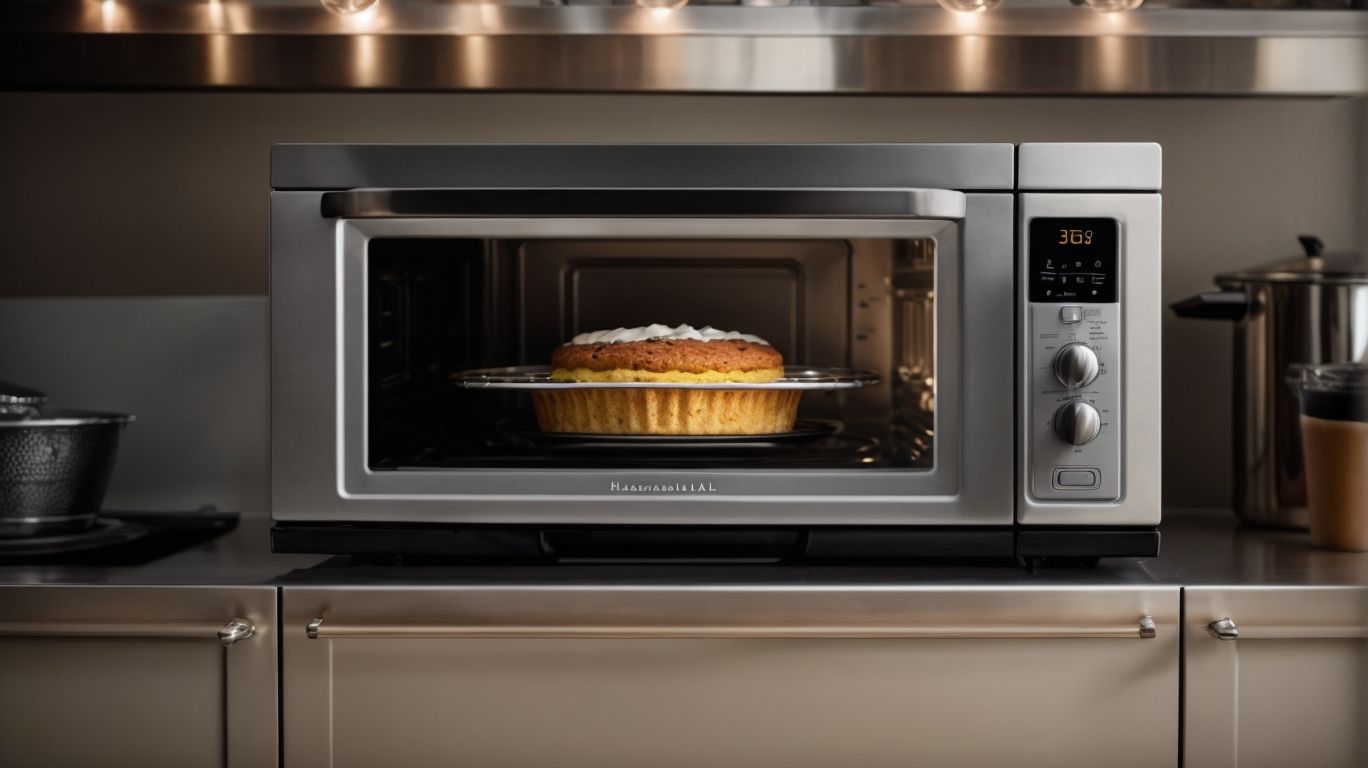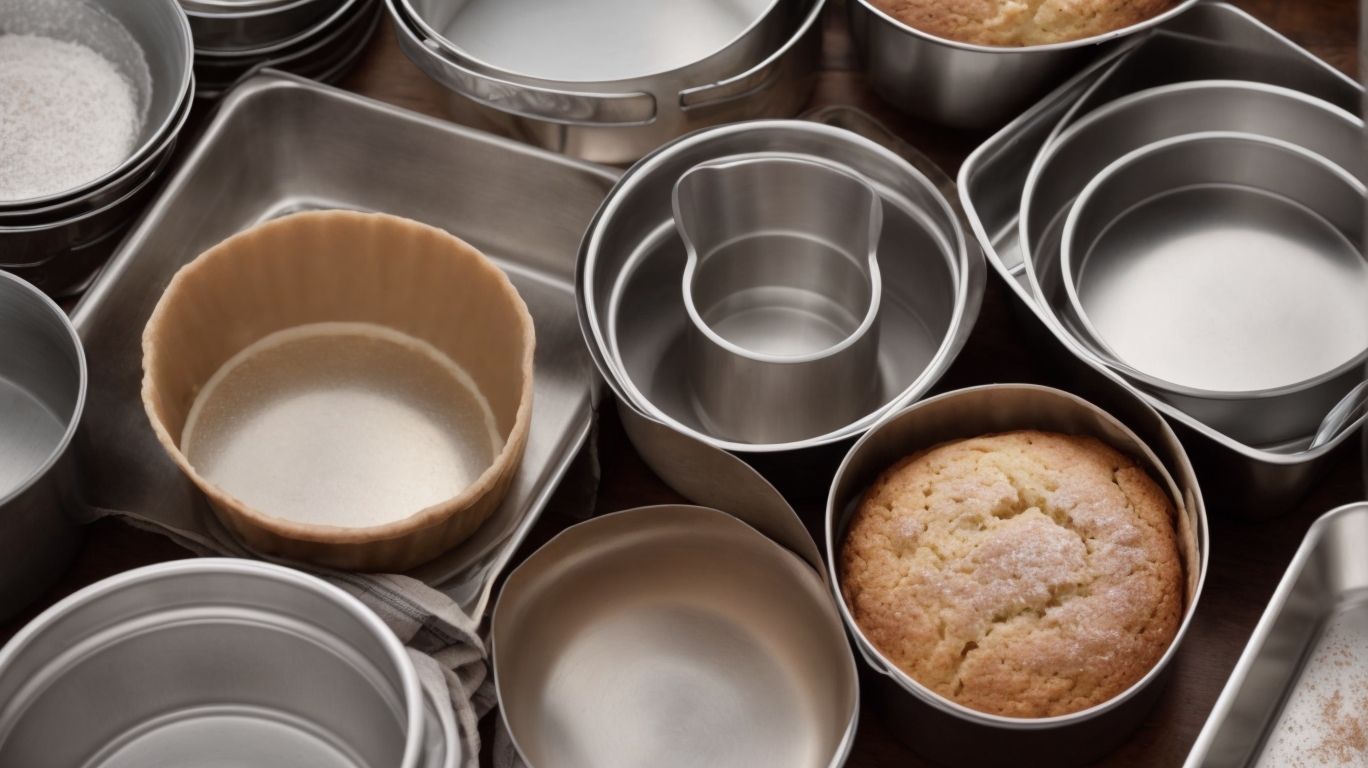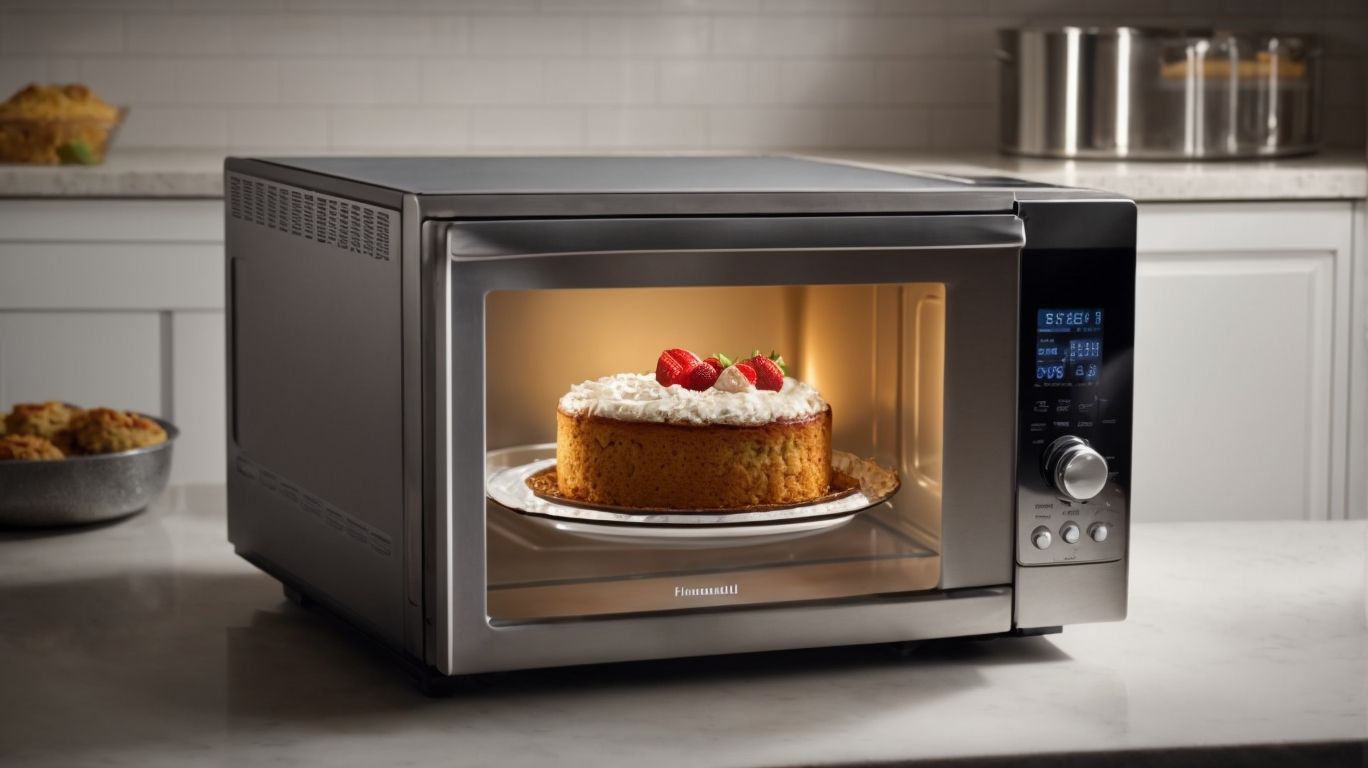How to Bake a Cake in Microwave Oven With Convection?
Looking to elevate your baking game with a convection microwave oven?
In this article, we explore baking a cake using this versatile appliance. Find out how a convection microwave oven works, select the right ingredients and pans, and follow our step-by-step guide to prepare the perfect cake batter, bake it to perfection, and learn how to decorate and serve your delicious creation.
Impress your friends and family with a mouth-watering homemade cake!
Key Takeaways:
What is a Convection Microwave Oven?
A Convection Microwave Oven is a versatile kitchen appliance that combines the functions of a traditional microwave and an oven, offering users the convenience of fast cooking along with the capability for baking and grilling.
One of the main distinguishing features of a Convection Microwave Oven is its ability to circulate hot air inside the cooking chamber using a fan. This convection technology ensures even heat distribution, resulting in perfectly cooked dishes with a crispy exterior.
These ovens often come equipped with pre-set cooking modes for different types of food, making it easy for users to select the appropriate settings without having to guess the cooking times and temperatures.
How Does a Convection Microwave Oven Work?
A Convection Microwave Oven operates by combining microwave technology for quick heating and convection technology for even cooking, allowing users to adjust modes, temperatures, and grilling functions for precise culinary results.
When utilizing the microwave feature, the oven emits electromagnetic waves that penetrate food, exciting water molecules to generate heat rapidly. On the other hand, the convection function circulates hot air inside the oven, ensuring uniform heat distribution for baking, roasting, or crisping. By selecting different modes such as microwave-only, convection-only, or a combination of both, users can tailor the cooking process to suit various recipes. Tweaking the temperature settings and activating the grill mode adds versatility to the culinary creations, enabling users to achieve that perfect texture and flavor.
What Are the Benefits of Baking a Cake in a Convection Microwave Oven?

Credits: Poormet.Com – Arthur Mitchell
Baking a cake in a Convection Microwave Oven offers numerous advantages, including faster baking times, even heat distribution, and the ability to achieve a golden crust while retaining moisture in the cake.
One key benefit of using a Convection Microwave Oven is the accelerated baking process it provides. The combination of microwave technology with convection heat circulation ensures that your cake bakes swiftly and evenly, saving you precious time in the kitchen.
- The uniform heat distribution in these ovens eliminates hot spots, preventing your cake from burning or getting undercooked in certain areas.
- This consistent temperature across the oven cavity results in cakes with a perfectly baked crust that boasts a delightful golden hue, appealing both visually and in taste.
- Another advantage lies in the moisture retention capability of Convection Microwave Ovens, ensuring that your cake remains moist and soft, unlike in traditional ovens where moisture loss can occur during prolonged baking.
What Are the Ingredients Needed for Baking a Cake in a Convection Microwave Oven?
To bake a cake in a Convection Microwave Oven, you will require a specific set of ingredients such as flour, sugar, eggs, butter, baking powder, and flavorings to create a delicious and well-textured cake.
Each of these ingredients plays a crucial role in the final result of your cake. Flour provides the structure, giving the cake its overall strength and integrity. Sugar not only sweetens the cake but also adds moisture and tenderness. Eggs act as a binding agent, helping to hold everything together while also providing richness. Butter adds flavor and moisture, contributing to a tender crumb.
- Baking powder is essential for leavening, helping the cake to rise and achieve a light and airy texture.
Finally, flavorings such as vanilla extract or cocoa powder enhance the taste profile of the cake, making it uniquely delicious.
What Is the Role of Each Ingredient in Baking a Cake?
Each ingredient used in baking a cake plays a crucial role in determining the final taste, texture, and appearance of the cake. From flour for structure to eggs for binding and leavening agents for rising, every component contributes to the overall baking process.
Flour, which provides structure through gluten formation, also affects the crumb texture. Sugar not only sweetens but tenderizes the crumb by preventing the formation of too much gluten. Eggs, rich in proteins, provide moisture and act as a binding agent. Baking powder and baking soda help in leavening by releasing carbon dioxide gas when mixed with liquid ingredients. Each precise measurement and accurate technique ensure the perfect balance of flavors, textures, and consistency in the cake.
How to Prepare the Cake Batter for Baking in a Convection Microwave Oven?
Preparing the cake batter for baking in a Convection Microwave Oven entails mixing the dry and wet ingredients to achieve a smooth consistency, ensuring proper aeration for a light and fluffy cake texture.
Once you have gathered all your ingredients, start by sifting the dry ingredients like flour, baking powder, and salt in a bowl to remove any lumps and aerate the mixture.
In a separate bowl, whisk together the wet ingredients such as eggs, milk, and oil until well combined.
Slowly pour the wet ingredients into the dry mixture, using a folding motion to incorporate them gently. Avoid overmixing as it can lead to a tough cake. The key is to achieve a homogeneous batter that falls off the spoon easily but still holds its shape. This step is crucial for ensuring that the cake rises evenly during baking in the Convection Microwave Oven.
What Are the Different Techniques for Mixing the Batter?
Various techniques can be employed to mix cake batter effectively, such as folding for delicate batters, creaming for rich textures, and whisking for lighter cakes, each method contributing to the final cake’s consistency and flavor.
Regarding folding, this gentle method is perfect for incorporating airy ingredients like whipped egg whites into the batter without deflating them, ideal for creating spongy chiffon cakes or angel food cakes.
Creaming, on the other hand, involves beating butter and sugar together to create a smooth and creamy mixture, perfect for dense pound cakes or classic butter cakes that rely on a rich and moist texture.
Lastly, whisking introduces air into the batter, creating a light and fluffy texture, making it ideal for creating delicate sponge cakes or genoise.
What Is the Ideal Baking Time and Temperature for a Cake in a Convection Microwave Oven?
Determining the ideal baking time and temperature for a cake in a Convection Microwave Oven is crucial for achieving a perfectly baked result. The recommended settings may vary based on the recipe, size of the cake, and the specific microwave model used.
When setting the baking time and temperature in a Convection Microwave Oven, it’s essential to consider the ingredients and consistency specified in the recipe. Some cakes may require a lower temperature for a longer time to ensure even baking, while others might need a higher temperature for a shorter duration. The size of the cake plays a significant role in determining the optimal settings. Larger cakes generally need lower temperatures and longer baking times to prevent undercooking. The characteristics of the microwave oven itself, such as its power output and distribution, can also impact the baking process.
What Are the Different Types of Pans to Use for Baking a Cake in a Convection Microwave Oven?

Credits: Poormet.Com – Gerald Green
Choosing the right type of pan is essential for successful cake baking in a Convection Microwave Oven. Options include glass cake dishes, silicone baking items, aluminum baking tins, and ramekins, each providing unique benefits for specific cake recipes.
Glass cake dishes are fantastic for even baking and heat distribution, giving your cakes a consistent texture. The transparency of these dishes also allows you to monitor the browning process without opening the oven.
On the other hand, silicone baking items are flexible, making it easy to remove cakes without sticking. They are also lightweight and easy to clean.
Aluminum baking tins are sturdy and conduct heat well, resulting in cakes with crispy edges, ideal for certain recipes.
Lastly, ramekins are perfect for individual cakes or mini desserts, offering a charming presentation for your creations.
How to Choose the Right Pan for Your Cake?
Selecting the appropriate pan for your cake involves considering factors such as the recipe requirements, size and shape of the cake, and the material of the pan, ensuring the even distribution of heat and optimal baking results.
For recipe requirements, it’s crucial to follow the instructions closely – some cakes may need a specific pan type or size for the best outcome.
Regarding size and shape, the depth and dimensions of the pan impact the baking time and evenness. Make sure the pan material is suitable for uniform heat distribution; metal pans are often preferred over glass or silicone for their heat conductivity.
Considering these factors will help you choose the perfect pan and bake a delicious cake in your convection microwave oven.
What Are the Steps for Baking a Cake in a Convection Microwave Oven?
The process of baking a cake in a Convection Microwave Oven involves several key steps that include preheating the oven, preparing the pan, pouring the batter, baking the cake, and testing for doneness to ensure a successful baking outcome.
Preheating the oven is crucial as it ensures that the temperature is stable and consistent throughout the baking process, helping the cake rise evenly. It also aids in achieving that perfect golden-brown crust on the outside while keeping the inside moist and fluffy.
Preparing the pan involves greasing or lining it with parchment paper to prevent the cake from sticking. This step is essential to ensure that your cake comes out of the pan easily without any damages.
Once the pan is ready, pouring the batter carefully into it is important. This ensures even distribution of the batter and helps in creating a uniform texture in the finished cake.
Step 1: Preheat the Oven
The initial step in baking a cake in a Convection Microwave Oven is to preheat the oven to the recommended temperature specified in the recipe, allowing for even heat distribution and consistent baking results.
This critical preheating step ensures that the oven cavity reaches the ideal temperature necessary for the cake batter to rise properly and set the structure of the cake. Preheating typically takes 10-15 minutes depending on the oven model, but it is crucial to not rush this process as it sets the foundation for the entire baking experience. For best results, utilize an oven thermometer to verify the internal oven temperature matches the set temperature on the display.
Step 2: Prepare the Pan
Preparing the baking pan involves greasing or lining the pan with parchment paper, ensuring the cake does not stick during the baking process and facilitating easy removal post-baking.
Before greasing the pan, it’s essential to select the right type of greasing agent. Popular choices include butter, oil, or non-stick cooking spray. To evenly distribute the greasing agent, use a pastry brush or a paper towel. Dusting the greased pan with a light layer of flour can further prevent sticking. For parchment paper users, trim the paper to fit the bottom of the pan perfectly. After greasing or lining, consider flouring the sides of the pan as an extra precaution against any potential sticking and to ensure a smooth cake release.
Step 3: Pour the Batter into the Pan
Once the batter is prepared, pour it into the prepared pan, ensuring a smooth and level distribution for uniform baking and consistent cake texture.
To achieve this, hold the pan steadily with one hand while pouring the batter with the other. Start by pouring the batter in the center of the pan, allowing it to naturally spread towards the edges. Use a spatula to gently spread and level the batter, ensuring it reaches all corners of the pan.
Remember, an even distribution of batter is crucial for the cake to rise uniformly during baking. This will result in a perfectly baked cake with a consistent texture. Avoid overfilling the pan, as it may lead to uneven baking and potentially a sunken center.
Step 4: Bake the Cake
Place the prepared cake pan in the Convection Microwave Oven and set the appropriate baking mode and temperature as per the recipe instructions, allowing the cake to bake to perfection.
When setting the baking mode on your Convection Microwave Oven, be sure to choose the convection setting for an even distribution of heat leading to a nicely baked cake. The temperature selection is crucial in achieving the desired texture and doneness; follow the recommended temperature range provided in the recipe for best results. Keep a close eye on the baking duration, adjusting as needed based on the visual cues like browning and firmness. Remember, each oven may vary slightly, so stay vigilant to prevent over-baking.
Step 5: Test for Doneness
To determine if the cake is fully baked, perform the doneness test by inserting a toothpick or cake tester into the center of the cake – if it comes out clean, the cake is ready to be removed from the oven.
If the toothpick or tester comes out with wet batter or crumbs clinging to it, the cake needs more time in the oven. It’s crucial not to rely solely on the appearance of the cake’s top, as sometimes the surface may appear done while the center is still undercooked. This method of testing for doneness is essential to ensure that your cake is perfectly baked, with a tender crumb and moist texture throughout. Remember to allow the cake to cool before serving for the best taste and texture.
How to Decorate and Serve Your Cake?

Credits: Poormet.Com – Dennis Hernandez
Once the cake is baked and cooled, decorating it with frosting, fruits, nuts, or sprinkles can enhance its visual appeal and flavor, making it ready to be served and enjoyed as a delightful treat.
Regarding frosting, you can choose between buttercream, cream cheese, or fondant to give your cake a smooth and luscious finish. Consider adding a touch of vanilla extract or food coloring to customize the frosting to your liking.
For fruit toppings, fresh strawberries, blueberries, or kiwi slices can add a burst of color and freshness. Arrange them artistically on the cake’s surface for a beautiful presentation that’s also delicious.
- To add a crunchy element, sprinkle chopped nuts such as almonds, walnuts, or pistachios on top of the frosting. This not only provides a contrasting texture but also adds a nutty richness to each bite.
- For a fun and festive touch, consider sprinkling colorful sprinkles, edible glitter, or chocolate shavings over the cake. This can make your creation look more inviting and appealing, especially for special occasions.
Frequently Asked Questions
1. Can I bake a cake in a microwave oven with convection?
Yes, you can bake a cake in a microwave oven with convection. It is a quick and convenient way to make a delicious cake without using a traditional oven.
2. What is the difference between baking a cake in a microwave oven with convection and a traditional oven?
The main difference is the speed of cooking. A microwave oven with convection uses a combination of microwave and convection technology, which speeds up the cooking process. Traditional ovens only use convection heat, which takes longer to bake a cake.
3. What type of cake can I bake in a microwave oven with convection?
You can bake any type of cake in a microwave oven with convection, including sponge cakes, pound cakes, and even cheesecakes. Just make sure to adjust the cooking time and temperature accordingly.
4. How do I adjust the cooking time and temperature when baking a cake in a microwave oven with convection?
In general, you can decrease the cooking time by 25% and lower the temperature by 25 degrees when using a microwave oven with convection. However, it is best to follow the recipe instructions for best results.
5. Do I need to use special baking dishes for baking a cake in a microwave oven with convection?
Yes, it is recommended to use microwave-safe baking dishes when using a microwave oven with convection. These dishes are usually made of glass or ceramic and can withstand the high temperatures and rapid cooking process.
6. Can I use a microwave oven with convection to bake other types of desserts?
Absolutely! In addition to cakes, you can use a microwave oven with convection to bake cookies, brownies, and other delicious desserts. Just make sure to adjust the cooking time and temperature accordingly for each recipe.

